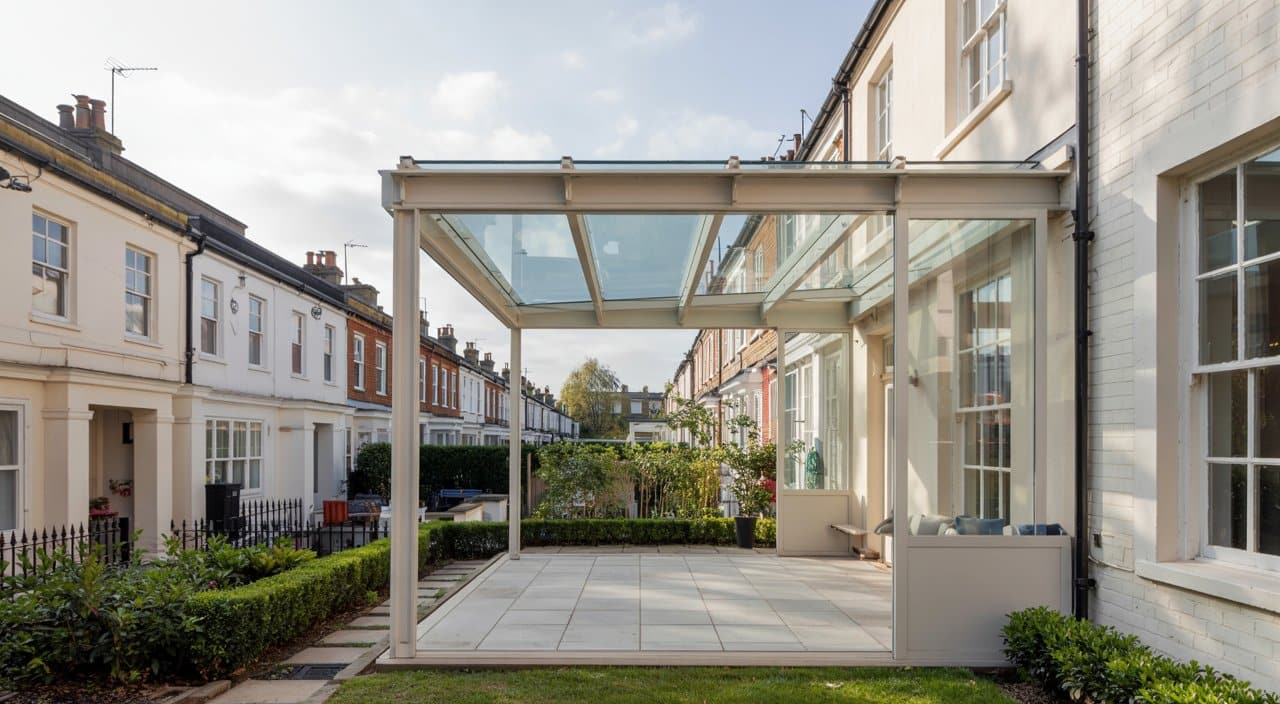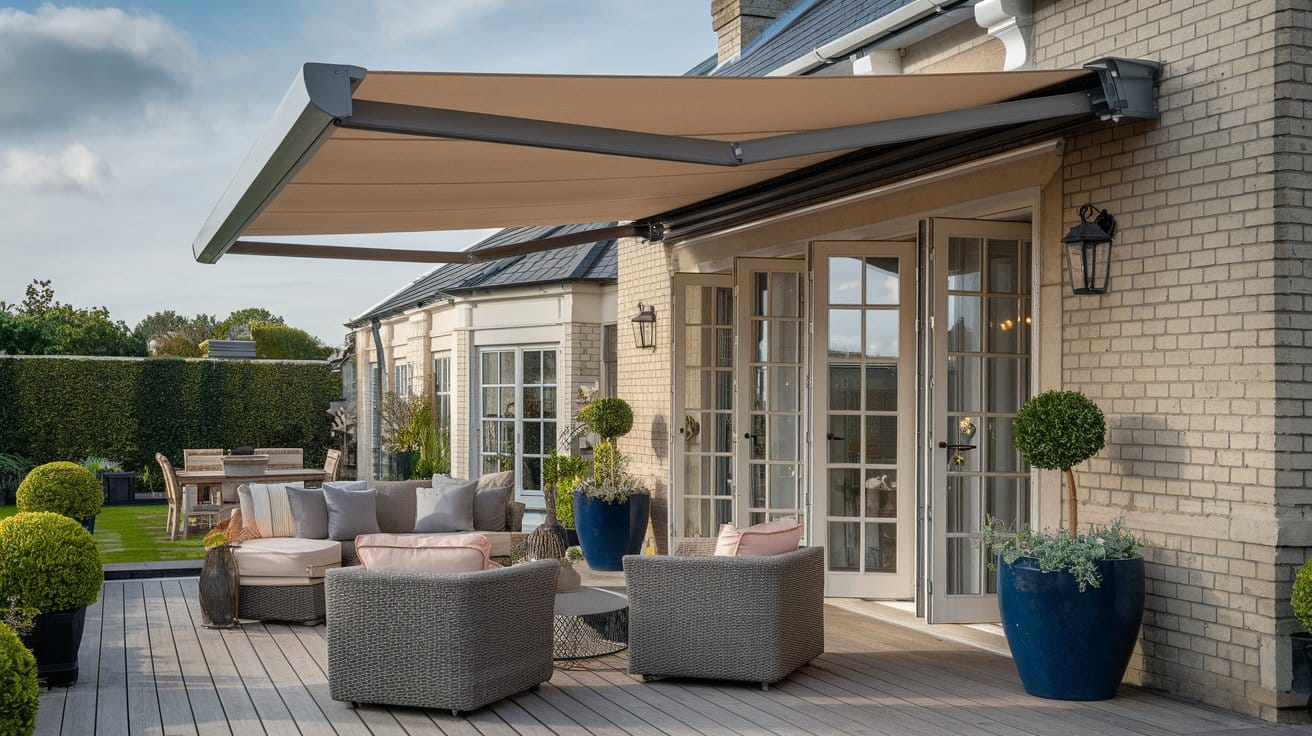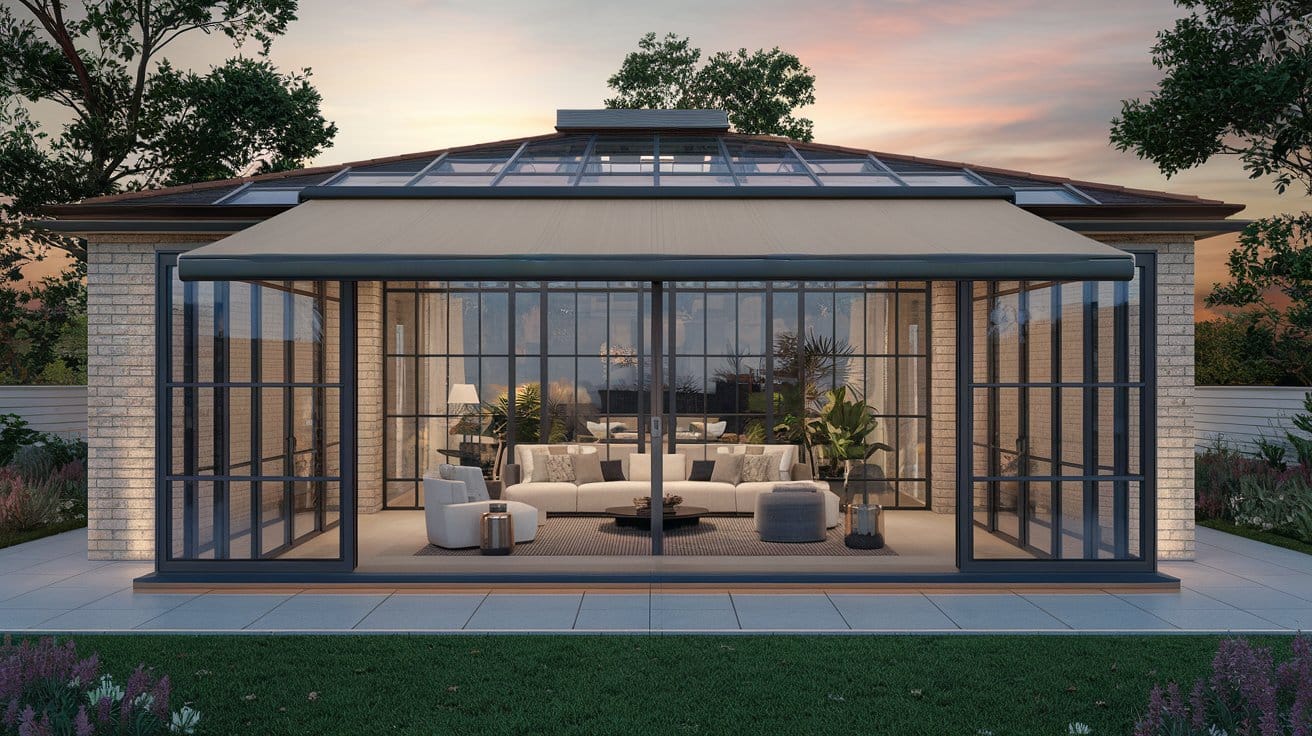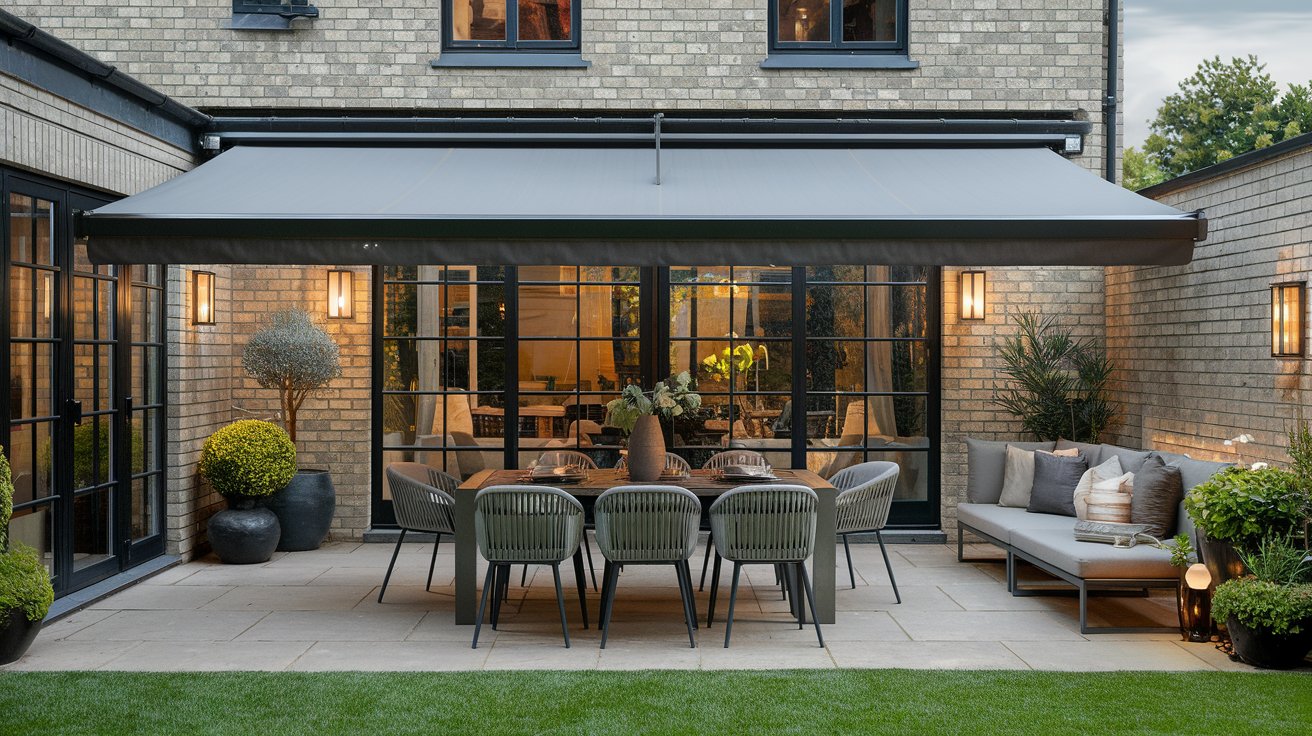What Are the Authoritative Cost Drivers in Glass Patio Roof Projects?
The path to an enduring, luminous outdoor retreat always collides first with cost opacity. Homeowners searching for transformation too often find a market smudged by incomplete quotes, fluctuating materials rates, or fine print that only emerges once work is underway. Genuine clarity begins by breaking down this fog into atomic factors—the fixed, the variable, the avoidably hidden.
Technical Foundations: Material, Structure, and Engineering
Every quote is anchored in a set of architectural decisions. Glass thickness—whether 8mm, 10mm, or multi-layer laminated—is not an upgrade-for-appearance: it’s dictated by the required span, environmental exposure, and safety certification. Untempered panels buckle or chip under wind loading; budget choices exact their price during storms, not at the desk. For weighty, broad installations, only heavy-gauge, Weinor-certified aluminium supports deliver long-term alignment and resilience, avoiding warping, slippage, or the creep of leaks over time.
Frame material is a multiplier:
- Aluminium secures durable, weather-fast structure with minimal care.
- Composite or steel raises up-front spend but may be required for unusual shapes or loads, especially in areas exposed to high winds or snow.
Hidden Multipliers: Access, Drainage, and Geography
Every home confronts hidden terrain. Difficult access, such as confined gardens or upper-storey patios, often necessitates bespoke cranage, scaffolding, or phased hand-carry—each potentially inflating labour bills by thousands. Drainage is another quiet cost: a well-drained patio roof prevents pooling, staining, and freeze-cracks, often requiring discrete design changes to grading or underground pipework.
“We’d seen attractive prices online—but nothing made sense until every variable was physically surveyed and explained.”
The Decision Table: Linking Intent to Value
Here’s how these components combine:
| Driver | Typical Range / Options | Function/Impact |
|---|---|---|
| Glass Thickness | 8–12mm/laminated | Safety, noise, solar, insurance |
| Frame Material | Alu/Comp/Steel | Durability, shape, finish, maintenance |
| Span/Modularity | 3-7m; single/multi-panel | Light, feel, instal cost |
| Drainage | Surface, built-in, custom | Avoid hidden moisture & repair costs |
| Access/Instal | Standard, scaffold, cranage | Timeline, complexity, surge pricing |
Every step to transparency is a step toward control. Our consultants at The Outdoor Living Group open every survey with these variables—no detail archived, no “TBA”—so you shape the cost, not the other way around.
Why Do Glass Choices and Standards Change Your Lifetime Value?
Glass is the invisible but determining architect of your comfort. Anyone who treats glass as one possible box to tick—regardless of orientation, usage, or climate—misses most of the return and inherits every penalty. Glass specification is the silent partner to both comfort and capital.
Glass Type: Upfront vs. Enduring Performance
Low-iron, heat-soaked, or acoustic-laminated options change not just how your patio feels, but its shape through time. Heat-reflective coatings cut summer baking and fade, extending usability deep into August days. Laminated glass dampens noise: vital if you’re near a busy road, trainline, or school, and should never be considered ‘luxury’ but prudent adaptation.
Long-term insurance: Codes and coverage evolve. Glass rated “passing” 10 years ago may fail future compliance or home insurer standards.
> “We assumed all glass was equal—until we realised one type kept us cool in summer and warm in winter—and didn’t turn the room into an echo chamber.”
Thickness, Safety, and Regulatory Edge
- 10/12mm glass: Required for major spans and to pass snow load codes in urban high-risk properties.
- PVB safety laminate: Prevents shattering, meets insurers’ modern mandates.
- Acoustic glass: Essential where sound intrusion or privacy (from neighbouring homes or commercial traffic) is a pain point.
- Self-clean coatings: Modest add-ons now, major reduction later in maintenance spend.
Value Grid: Selection to Outcome
| Glass Feature | Direct Impact | Lifetime Benefit |
|---|---|---|
| Solar coefficient | Temperature, fade, glare | Lower HVAC, longer use season |
| Acoustic rating | Speech clarity, noise ingress | Day/evening usability |
| Safety/lamination | Risk reduction | Insurance approval, peace of mind |
| Self-clean/thermal | Maintenance, view quality | Lower cleaning, enduring clarity |
Selecting for now is only half the equation. Selecting for every future need anticipates resale, retrofit, and insurance outcomes—and that’s the level of future-proofing we guarantee in our glassroom and veranda guidance.
How Does Installation Complexity Impact Finish, Price, and Timeline?
A design-led homeowner plans for clarity, but only a few see how installation complexity turns blueprints into (or away from) reality. Every site is a living puzzle: space, access, timing, historic overlays, even neighbour permissions all shift the timeline and total sum owed.
The Chain of Complexity
Site access directly alters the method and tempo of work.
- Wide, low-access gardens: Streamlined instal, less risk, tighter budgets.
- Upper-floor patios or urban infill: Lifting restrictions, scaffold phases, congestion charges, insurance surges.
Timeline multipliers:
- Weather: A rained-off week or early frost transforms phased schedules and labour hours.
- Material logistics: Custom-framed glass cannot be rushed. Variance in delivery, ground beaming, or client design changes extends the critical path.
- Phased construction: Some properties require sequencing—removal, inspection, felt layer prep, then main build—to comply with code or ensure waterproofing.
“One neighbour’s boundary dispute delayed us a month—glad the process accounted for setbacks instead of charging us for delays.”
Matrix mapping: Installation Factors and Their Cost
| Factor | Budget Impact | Timeline Impact |
|---|---|---|
| Access (ground, upper) | –$$ | +0 to +2 wks | | *Urban regulations, permits* | $ | +0 to +5 days | | *Ground/utility readiness* | $$ |
+0 to +2 wks |
| Weather phasing | |Variable||*Historic/neighbouroverlay*|$ | Variable/extensive |
Our installation method at The Outdoor Living Group is engineered for certainty: risk-mapped, time-stamped, and phased to preserve both schedule and outcome. We communicate every variable, so you’re never left caught between project float and family routines.
What Custom Features and Upgrades Offer Real ROI?
A glass patio roof is more than a threshold; it is a bridge between functional shelter and lived experience. Choosing custom features isn’t about adding for the sake of excess—it’s an act of future-proofing and lifestyle alignment.
The Upgrade Spectrum
- Integrated LED lighting: Expands use into evenings, seasonal transitions.
- Heated beams and flooring: Extends use into the chill of autumn and even winter, letting gatherings or calm persistence stretch.
- Privacy panels, VertiTex side screens, and mirrored finishes: Ensure that every breakfast, dinner, or party is both seen and shielded as intended.
- Frameless sliding doors: Redefine the boundary between inside and garden, enabling moments no ‘standard’ roof ever could.
- 200+ RAL frame colour choices: Provides architectural integration, avoiding the “add-on” look.
“The moment the privacy screen dropped and the LEDs dimmed, our night garden became a new space to unwind.”
Commercial Value Scenario: For hospitality venues, modular upgrades push return on investment into every quiet morning and bustling dinner. Ambient control drives up seat time, positive reviews, and most measurably, flexible revenue streams through every forecast. A feature left out is potential left on the table—or in the hands of a competitor.
Phased Approach (Table of Upgrades):
| Upgrade | Lifestyle Benefit | Added Value |
|---|---|---|
| LED/Heated | Season extension | Lowered cost per use |
| Privacy/Screen | Visual comfort | Resale, neighbour compliance |
| Frameless Doors | Full weather control | Modern design, higher ROI |
| Custom Colour | Seamless architecture | Resale appeal, differentiation |
Our process at The Outdoor Living Group always includes an honest roadmap of which upgrades can—and should—be prepped in the original fit, which can be sensibly adopted later, and where future regrets are most likely if choices are deferred.

When Do Planning, Compliance, and Location Dictate Feasibility and Cost?
The smoothest build can grind to a halt the moment unforeseen regulation, local zoning, or compliance needs intervene. Permit silence is an illusion—every roof exists inside a culture, a community, and an evolving legal envelope.
Planning: The Silent Project Multiplier
Regulatory overlays make all the difference.
- Conservation, listed, or special heritage zones: Even colour choice is vetted.
- Urban overlays: Loss-of-light calculations, overshadowing analysis, and sometimes even sustainability audits can delay or upend an instal.
- Rural wind/snow loads: These require enhanced glass and frame matrices, overruling “budget” options common in city settings.
Compliance: Beyond a Signed Off Certificate
- UK Building Regulations rely on updated codes: what passed a decade ago cannot be trusted until rechecked.
- Eco-material requirements: Many local authorities now demand VOC-free finishes, recycled metal, or Green Guide-certified timber.
- Insurance & liability: Non-compliance means non-payout on future claims, multiplying the cost if not upfront.
“They never left us alone with planning forms—every approval was their responsibility, not another item on our list.”
Avoiding bottlenecks is a question of expertise—at The Outdoor Living Group, we preset every timeline for compliance milestones, coordinate with authorities, and adapt designs to the timelines you want, not the ones forced by dried ink approval or neighbour disputes.
Where Are Hidden and Ongoing Costs Most Likely to Arise?
Few homeowners budget beyond day one, but real cost is lived, felt, and seen across seasons. Maintenance, aftercare, and unexpected events shape the full graph of true cost.
The Ownership Lifecycle: Where Expenses Hide
- Cleaning: Frequency increases with proximity to trees, wildlife, or pollution corridors; annual self-cleaning glass or pro surface treatments add upfront, subtract labour down the line.
- Hardware/Seal/Component swaps: Unserviced details like hinge sets or post seals can void warranties or halve usable life if ignored.
- Insurance: Glass is often subject to higher premiums and specific riders; non-compliant fit means limited or denied payouts after storm or impact.
- Aftercare plans: Check terms: free callouts vs “first-year only,” transparent or free upgrades vs. nouns like “subject to stock.”
- Upgrades and adjustment: Delaying features like sidewalls or LED kits can increase instal costs by up to 40% compared to fitting as part of first build.
“Our previous installer billed extra to swap a failed sensor, and told us retrofitting lights ‘wasn’t possible’—until a real expert showed us how.”
To safeguard long-term value, our structure at The Outdoor Living Group covers:
- Full lifecycle documentation, with recommended maintenance intervals
- Warranty coverage mapped to each feature, not just the base instal
- Conditional upgrade pathways, ensuring today’s decision doesn’t block tomorrow’s need
Ownership is not a passive achievement—it’s an investment in comfort, resilience, and sustained joy.
How Can You Secure a Transparent, Fully Itemised, No-Surprise Quote?
The modern homeowner expects, and deserves, full visibility. Quotes missing essential detail—glass grade, access hours, warranty specifics—aren’t proposals, but invitations for future friction.
Flags of Transparency (Checklist)
- Clear designation of every material, frame finish, and glass specification: There should be zero question about what’s being purchased.
- Itemised labour charges, including premium fit or delivery means, not buried as a “composite” fee.
- Explicit line for every regulatory, approval, and aftercare item; pre-populated, not “to be advised.”
- Future upgrade pathways and their expected fitment or labour cost.
- Warranty and insurance details—not just span, but coverage for every primary and upgrade feature.
- Visual overlays: Before-and-after, sample matching, or plotted site assessment visuals to remove all ambiguity about outcome and site constraints.
“We expected to hunt for hidden costs, but everything was defined—down to the last bolt.”
The unique process at The Outdoor Living Group makes transparency the default, not the ask. We prepare clients for comparison, not conversion, believing that informed buyers build lasting relationships—moving friction into the open, and replacing uncertainty with excited, prepared decisions.
For a Free, Expert-Led Design Consultation, Contact The Outdoor Living Group
Every task above converges on this reality: comfort, design harmony, and confidence are not by-products. They are direct outcomes of an open, architecturally literate process that sets your needs in the centre and supports every possible desire or concern with technical mastery. Talk to us, and your process begins with every question answered, at your pace, at a level of depth that anticipates both lifestyle and future transformation.
Feel the difference that comes from insight-led planning, honest costing, and decades of applied expertise—the moment your glass roof creates a gathering place, not just a structure.
Frequently Asked Questions
When Do Planning, Compliance, and Location Dictate Feasibility and Cost?
Navigating Hidden Layers of Regulation
Visualise the first weeks after your mind has settled on a glass roof transformation. It isn’t the allure of your envisioned garden space that falters, but paperwork, permissions, and outbreaks of uncertainty: will your privacy screens be vetoed by the council, does your postcode trigger flood plain rules, and will that “perfect fit” glass specification suddenly be disallowed by a conservation officer? Homeowners, restaurateurs, and designers alike underestimate that compliance and location-specific regulation shape not only feasibility, but budget, design opportunity, and timeline.
“Planning isn’t a hurdle to jump—it’s the course itself. Miss a foothold, and your vision stalls for months.”
Regulatory Friction: The Unseen Decision-Maker
Heritage overlays, conservation clauses, or daylight impact reports can force your hand on design, material, or permissible features. Suburban councils scrutinise colour, reflectivity, and even rainwater runoff, while city locales demand overshadowing schedules and engineering sign-offs. The project team that makes regulatory clarity their starting line offers you a vital distinction: freedom of design anchored by foresight.
- Conservation zones can restrict colour, aspect, and placement—paperwork and photomontages delay but also legitimise the result.
- Urban settings shift focus to neighbour impacts, scaffolding logistics, and transport disruptions. Every council query answered before works commence means hundreds of pounds (and days) saved.
- Rural or weather-exposed locations create a silent premium on glass thickness, storm-rated fixing, and structural upgrades—these should never be a surprise expansion to scope.
Compliance: An Evolving, Not Static, Requirement
Understanding compliance means more than reading last year’s code. Building regulations, energy standards, and eco-certification rules keep shifting—ignoring them means risking forced retrofits, insurance denials, or sale-blocking red flags later. Our approach at The Outdoor Living Group integrates third-party code review, product provenance, and legal documentation into every scope document and timeline. Compliance isn’t a hoop to leap, but a thread woven through every decision, removing uncertainty at each turn.
Regulatory impact table:
| Regulation/Constraint | Typical Project Impact | How We Offset |
|---|---|---|
| Heritage/conservation | Slower approval, design limits | Early council liaison, precedent files |
| Urban impact | More permits, working hour caps | Dedicated planner, pre-approval planning packs |
| Eco-material mandate | Upfront material cost, delay | Supplier certifications, fast-track document sets |
| Flood/snow load | Higher glass/frame spec | Engineer-led design, staged compliance checks |
Anticipating Location-Specific Triggers
Each postcode comes with quirk and challenge: the neighbour two feet from your extension, the redrawn floodplain, the street with five other renovations already backed up at committee. Our project team gets in front of these delays with a mapped calendar of compliance milestones, making each stage transparent and shortening the time from dream to daily use. Every regulatory challenge mastered becomes a trust and speed advantage for your vision.
Where Are Hidden and Ongoing Costs Most Likely to Arise?
The Full Ownership Equation
The glow of a new glassroom fades fast if it arrives bundled with never-discussed maintenance headaches, warranty surprises, or insurance disclaimers. Ownership, by its nature, reveals costs that glossy brochures and sales scripts tend to omit. We believe mapping those realities not only builds comfort but creates long-term satisfaction.
“It looked perfect after day one—but true peace of mind only came once we understood who would keep it that way.”
The Lifecycle of Maintenance and Upkeep
No glass surface stays pristine for long unaided. Trees, birds, pollen, and polluted rainfall transform clear panels into streak-laden barriers. In busy city settings or leafy streets, self-cleaning coatings, specialised surface treatments, and regular maintenance reduce not only labour but the chance of sightline loss or water build-up.
- Annual service matters: Gasket swaps, rail lubrications, and drainage checks are minor, but irreplaceable—lack of these shortens useful life and voids warranties.
- Special glass or electronics: Integrated heating, LEDs, or automated blinds require both routine checks and insurer verification.
- Moving hardware and seals: Ignore them, and weather or shade both enter unbidden.
Warranty, Insurance, and Long-Range Value
A bold warranty headline needs context. Is glass excluded after ten years? Does friction damage or seal fatigue nullify coverage? The soul of a service contract sits in its “covered vs. not covered” rows—and the context you’ll find from real projects, not just the literature.
Components of true lifetime cost (table):
| Cost Source | Typical Range/Interval | Preventive Action |
|---|---|---|
| Glass cleaning/service | Seasonal/annual | Self-clean upgrade, pro service |
| Hardware/seal replacement | 3-10 years | Maintenance schedule, premium spec |
| Insurance/inspection | Annual, post-incident | Policy review, aftercare plan |
| Retrofit upgrades (LED/privacy) | As needed | Plan for instal pre-wiring, staged purchases |
Homeowners and commercial clients alike should expect a mapped “full life” outlay, not just a chart of material SKUs. Our aftercare frameworks at The Outdoor Living Group are transparent: every upkeep item benchmarked in advance, every warranty period clear, every insurance hook anticipated rather than apologised for.
How Can You Secure a Transparent, Fully Itemised, No-Surprise Quote?
The Science—and Art—of Predictable Cost
Most glass roof buyers can recall the sobering moment when a “base” quote blossomed into a real price: every feature recast as an upgrade, every invisible labour item unveiled after work began. Only a rigorously detailed, fully itemised quote defends against these escalating totals and the feeling of loss of control. Transparency is not an add-on service—it’s a foundational promise.
“When every part and process, from survey to aftercare, was there in black and white, it changed the whole decision process.”
Itemization as Security
A real quote doesn’t bundle, blur, or leave unsaid what will cost more later. It should show:
- Every material: Not just “glass,” but thickness, coatings, colour, provenance—each with its role and its value.
- Labour, listed distinctly: Pre-build survey, groundwork prep, structure assembly, installations, weatherproofing, final cleanup.
- Regulatory and compliance items: Enumerated, not “TBA”; all council, permit, or recording costs plainly shown.
- Warranty and aftercare: Broken down for structure, glass, hardware, and any automation or smart control system.
- Future options: Whether you add privacy screens or climate control now or years from now, every cost for primary fit and later retrofit is described (never “see later” or bracketed in ambiguity).
Empowerment Through Clarity
Comparison is your shield. When two or more providers offer itemised, apples-to-apples transparency, you know what’s real and what is bluster—no more need for after-the-fact negotiation. Our standard at The Outdoor Living Group builds this empowerment into every proposal, training the buyer to chant the right questions (and the right refusals) for life.
| Quote Element | How It Appears in Transparent Proposal |
|---|---|
| Materials & Spec | Line-item, each variant & feature |
| Labour & Timeline | Separated by phase |
| Compliance | By permit or approval, expensed upfront |
| Warranty/Aftercare | Shown per feature/system |
| Optional Upgrades | Staged: primary vs retrofit pricing |
Rather than settle for an “all-in” number whose very vagueness hides risk, you stage your investment in open view; line by line, right-sized to your life, style, and future desires.
For a Free, Expert-Led Design Consultation, Contact The Outdoor Living Group
Contact is not a risk, a gauntlet, or an algorithmic transaction. It is where your real project begins—customised, pressure-free, mapped to your home, your site, and your timetable. Our design consultation is not a sales talk, but a solution session: every question is anticipated, every product variable explained with reference to real case studies, maps, and possibilities.
Your vision—whether a family retreat, garden dining room, or commercial venue—is protected from permit headaches, build regret, or unclear costing. This is comfort engineered: transparency at every step, readiness for every weather or neighbour, and a relationship that extends from first query to years of aftercare.
“You know you made the right call when the answer to every difficult question is already in your project folder.”
How Can I Compare Patio Roof Quotes to Ensure I’m Not Overpaying?
Choosing a patio roof is more than a matter of taste—it’s a high-stakes venture where vague quotes and missing details breed regret. Homeowners like you often find themselves sifting through stacks of proposals that look similar on the surface but diverge wildly when you examine the fine print. The stakes are high: make the wrong call, and you lock in overspending, endless extras, or a project that barely fits your lifestyle.
“Three quotes. Three different totals. The details never lined up, leaving us with more questions than answers.”
What Criteria Help Accurately Compare Glass Patio Roof Proposals?
Start by demanding a line-item breakdown. Every quote should read like an architect’s bill of quantities, not a wish-list. Each material, process, and service must stand alone, priced transparently:
- Glass specification—type, thickness, coatings, and safety rating
- Frame and support—material, finish, hardware scalability
- Installation and access—site prep, scaffolding, complex delivery charges
- Ancillary services—waste removal, groundwork, extra drainage, electrical integration for lighting or sensors
- Compliance—planning fees, engineering or Building Regs certificates
If you spot vagaries such as “provisional sum,” “to be confirmed,” or “subject to survey,” these are signals for unresolved—and potentially expensive—unknowns. Ask for clarity before you commit.
Recognising the Real Value—and Real Risks
It’s tempting to focus on totals, but the storey is in the details. The lowest price often omits essentials, hiding removal costs, aftercare, or even a code-compliant glass spec. Meanwhile, high-ticket “premium” proposals sometimes offer features dressed in jargon rather than substance.
Elements Every Transparent Quote Should Include:
| Must-Have Element | Why It Matters |
|---|---|
| Full glass specification | Guarantees safety and code approval |
| Complete frame/hardware detail | Ensures durability and finish match |
| Distinct labour phase costing | Averts labour “surge” or timeline warping |
| Regulatory/service inclusions | No surprise planning or recording fees |
| Warranty/service breakdown | Ties spend to support, not empty promises |
| Itemised upgrade/aftercare path | Predicts future value and flexibility |
When in doubt, ask for references—real homes, real homeowners. Verify that your prospective installer’s track record includes post-instal support, not just a list of “completed” jobs. A transparent provider will readily share insurance details, manufacturer certifications (such as Weinor Authorised status), and before/after visuals that match your ambitions.
Debunking the Industry “Standard”
It’s become habitual for suppliers to leave certain items as “TBA” or bundle aftercare into vague footnotes. This is not industry best practice; it’s a legacy trick. True transparency is rare—so when you find it, you gain control, not just a clearer quote. Our process at The Outdoor Living Group always ensures you never wonder what’s included, what’s extra, and who will stand behind each promise.
Why Is Ongoing Maintenance a Critical Part of Glass Patio Roof Ownership?
There’s nothing more disappointing than watching a gleaming new glass patio roof lose its sparkle because the years ahead were ignored at the outset. Maintenance is the unspoken thread connecting initial delight to lasting value, and most heartbreaks—cost overruns, failed insurance claims, lost warranties—trace back to neglect or misinformation here.
“We watched little glitches become big headaches because no one told us what needed regular care, or when.”
Yearly Maintenance Tasks & The Real Cost of Ownership
Every glass structure—especially in the UK’s shifting climate—demands attentiveness. Annual or seasonal servicing isn’t a suggestion; it protects your aesthetics, comfort, and investment. Key actions include:
- Glass cleaning/treatments: Especially where rain, pollen, or birds frequent, or in urban environments prone to soot and airborne pollution.
- Gasket and seal inspections: To prevent leaks, mould, and unnecessary draughts. Routine replacement every few years is normal.
- Track and hardware lubrication: Ensures smooth operation of sliding doors or motorised blinds, prevents wear and noise.
- Drainage and gutter checks: Keeps water flowing off instead of pooling and staining, ensuring frost doesn’t split seams or edges.
Distinguish between included aftercare—like our comprehensive, scheduled maintenance programmes—and aftermarket upsells or “first-year only” perks that vanish when you most need support. An “included” warranty may require user maintenance to remain valid; read policies closely, and demand clarity about what voids your coverage.
The Overlooked Cost of Neglect
Insurers and manufacturers will not honour claims if signs of skipped maintenance are found. Have your schedule in writing—our team automates reminders and logs every service, so your patio’s storey is “always cared for.” More than peace-of-mind, this preserves value and ensures your space looks as intended, year after year.
Excellence in Aftercare—Or the Road to Regret
An exemplary aftercare programme is a direct marker of installer confidence. If a company avoids answering about follow-up, or charges heavy call-out fees, this is a warning. With The Outdoor Living Group, our aftercare is fully mapped at the budgeting stage, tied to affordable, scheduled visits, and delivered by the same technical hands that built your project.
Where Do Glass Patio Roof Designs Offer Environmental Benefits—or Potential Pitfalls?
True sustainability isn’t a by-product—it’s foundational. Promises of “eco” or “energy-saving” features mean little unless backed by clear, technical decisions that reduce energy use, cut lifecycle emissions, and keep your home resilient through changing weather patterns.
“Eco was our dream, but no one would show the math. We nearly settled for words until the right designer mapped the energy flows and certifications.”
Engineering for Passive Solar Gain
Not all glass is equal. Products featuring low-E coatings, solar-reflective layers, or argon-filled cavities outperform ordinary panes by harnessing passive solar gain in winter while guarding against overheating in summer. The right specification for your position and climate transforms a glassroom from an energy drain into a thermal asset.
Sustainable Choices, Real Impact
- Recycled or certified aluminium frames mean major reductions in embodied carbon—ideal for retrofit or forward-looking new builds.
- VOC-free powder coating protects both your air quality and the environment.
- Smart shade systems reduce unnecessary heating or cooling demand, finely tuning comfort.
| Sustainability Feature | Hidden Value |
|---|---|
| Low-E/reflective glass | Lower heating/cooling costs |
| Recycled/certified frames | Lasting compliance, cleaner air |
| Automated/smart shading | Controllable year-round comfort |
| Eco-certification/documentation | Enhances property value, easy resale |
Standards evolve. With councils and financial incentives increasingly favouring verified green upgrades, ensuring your patio roof aligns today means it stays marketable tomorrow.
Navigating Traps & Pitfalls
Green marketing without third-party proof is just words. Insist every “eco” or “efficiency” claim in your proposal can be substantiated by measurable, branded certifications, and by the inclusion of future-ready smart features. Our design and fitment process at The Outdoor Living Group is built on this guarantee—offering both tech-forward gains and the eco-evidence to prove them.
What Future-Proofing and Modularity Options Exist for Glass Verandas?
The confidence to evolve, adapt, and customise is the most underappreciated source of life-long satisfaction in exterior design. Homeowners frustrated by locked-in, inflexible builds nearly always started with a system that wasn’t designed for change. Your comfort, your needs, and even your sense of style will shift; your patio roof must be adaptable without penalty.
“We never imagined we’d want more shade, or a heated seat in spring. But our space—and needs—changed, and our installer already had it mapped out.”
Building Blocks for Flexible Living
Think modularity as early as possible. A future-proof system considers:
- Blinds (manual or automated)
- Heated flooring or posts
- Lighting upgrades (from integrated rails to external features)
- Sliding glass doors or increased opening spans
- Upgradability for smart home integration or climate sensors
Our process ensures these capabilities are discussed, designed, and specced as primary considerations—not afterthoughts. Where possible, we pre-wire, pre-set tracks or rails, or use couplers and connectors that support phased additions.
Avoid Common Upgrade Pitfalls
The most frequent post-build frustration arises from proprietary or inaccessible systems—your installer does not (or cannot) return, your warranty is void, or “compatible” upgrades are simply not available after initial instal. Collaborate with companies that publish both upgrade roadmaps and candidly disclose limitations.
| Feature/Upgrade | Plan Early | Add Later | Risks if Ignored |
|---|---|---|---|
| Automated blinds | Ideal | Yes | Rewiring, extra scaffolding |
| Smart lighting | Preferred | Yes | Limited internal access |
| Extra infill panels | Advised | Yes | Style/colour mismatch |
| Heated flooring/posts | Needed | No* | Unviable post-build |
*Heated elements generally require foundational placement; late decision can make addition impractical or cost-prohibitive.
Maintaining Design and Warranty Harmony
Change should never mean visual mismatch or voided insurance. Our team ensures all modular paths include original palette and material planning, so each upgrade or addition continues your design, not breaks it. Warranties—both aesthetic and structural—remain intact, since our specs match manufacturer requirements from the outset.
A Flexible Future
It’s never “one and done” with architecture, yet too many homes settle for frozen potential. Future-proofing, at its best, is invisible—giving you control, evolving with you, and never forcing a trade-off between aspiration and reality.
Section 5: When Do Planning, Compliance, and Location Dictate Feasibility and Cost?
Securing a seamless installation isn’t just a matter of ordering the right materials or scheduling the team—it’s the mastery of a shifting regulatory, environmental, and social terrain. Drop one detail, and you risk months of delays, extra costs, or the requirement to undo and reapply after a failed inspection.
“Our last renovation got stuck for months in permit limbo. With the right partner, approvals arrived before we waited—and we stayed on timeline.”
Untangling the Web of Permission and Compliance
Different regions, cities, and even neighbourhoods have unique planning overlays. In conservation districts, authorities dictate everything from frame colour to reflectivity index. Urban settings layer further: overshadowing studies, proximity to boundary assessments, and council-imposed work hour caps add new forms of friction and demand experienced hands.
Regulatory Impacts on Cost and Timeline
- Planning permission: May require site plans, professional photomontages, site committee approval
- Heritage/conservation status: Restricts materials, colours, aspect, or even finish gloss rating
- Building regs compliance: Shifts as codes update; old specs are not “grandfathered” for new work
- Urban impact studies: Public notice, neighbour sign-off may be mandated
- Eco/green mandates: Certain sites now require recycled frames or eco-certified glazing
| Constraint | Common Delay | Impact | Solution |
|---|---|---|---|
| Planning permission | 1-3 months | Initial construction | Early council engagement |
| Conservation review | 2-4 months | Materials, finishes | Experienced documentation |
| Building Reg upgrade | 1-2 weeks | Structural cost | Pre-engagement compliance |
| Eco mandate | 2-8 weeks | Material selection | Pre-approved sourced supplies |
Adaptive Expertise: The Outdoor Living Group Way
Our project scoping and sequencing professionals aren’t just box-tickers—they’re regulatory ambassadors. Mastery means synchronising council timelines, engineer reviews, and supplier lead times, so approvals overlap rather than delay each other. By bringing the administrative and technical orchestration under one roof, we minimise the cost and emotional toll of each permit or code hurdle.
Section 6: Where Are Hidden and Ongoing Costs Most Likely to Arise?
It’s the fees you never planned for that undermine even the most carefully-calculated project. Homeowners like you deserve knowledge not only of what you’ll spend now, but how your choices will echo financially in the years—or decades—ahead.
“The instal felt affordable—until callouts, parts, and re-finishing fees started to appear, year after year.”
The Full Lifecycle View
A patio roof is not a one-time expense. Ongoing costs arise in several ways:
- Seasonal and annual cleaning: More frequent if your roof is under trees or near pollution sources; specialised coatings can help but never eliminate need.
- Hardware inspection and repair: Tracks, hinges, seals, and fasteners degrade with weather and use; regular checks and minor replacements stave off major failures.
- Insurance adjustments: Glazing premiums, smart feature riders, or loss-of-use coverage may change over time. Verify policy scope before and after instal.
- Warranty adherence: Many “lifetime” guarantees only apply with proof of regular care; missed services void coverage.
- Planned upgrades and retrofits: Adding features post-instal typically costs more—especially if original system wasn’t designed for expansion.
| Hidden/Ongoing Cost | Frequency | Mitigation Approach |
|---|---|---|
| Cleaning/surface care | 2x/year+ | Self-clean, scheduled service |
| Hardware checks | Annual | Maintenance logging, qualified tech |
| Inspections/warranty | Policy-specific | Keep service and instal records |
| Upgrades/retrofits | As needed | Original pre-wiring or future path |
Our aftercare, upgrade, and warranty documentation keep you informed—never in the dark. Anticipate every major calendar milestone and build them into your budget, knowing you’ll always be prepared.
Section 7: How Can You Secure a Transparent, Fully Itemised, No-Surprise Quote?
Few experiences erode trust faster than a “comprehensive” proposal that turns into a fiction of fine print, with once-hidden extras ballooning your investment. Only a transparent, fully itemised quote lets you predict and control every facet of your outdoor space investment.
“The best money I spent was on the quote review—because the worst money I nearly spent was on the line missing from it.”
Your Itemization Checklist
A quality quote should feature:
- Glass Details: Exact type, thickness, manufacturer, and coatings.
- Frame system: Brand, finish, joint type, weatherproofing, hardware.
- Labour scope: Prep, installation, and post-finish, with each phase costed.
- Permit/compliance line: Disclose all known council, engineer, or regulations charges.
- Warranty terms: Duration, coverage for components, conditions for claims.
- Accessory/upgrade pricing: List modular paths and future complexities up front.
Table: Sample Quote Breakdown
| Quote Category | Clear Itemization Example |
|---|---|
| Glass specification | “10mm low-e laminated by Weinor” |
| Frame/structure | “Anthracite aluminium, RAL 7016” |
| Installation | “Site survey, piston jack, 2-day fit” |
| Compliance fees | “Barnet planning fee, £450” |
| Aftercare | “First year service, yearly opt-in” |
| Upgrades | “Privacy screen pre-wire, +£230” |
A trustworthy installer will address every uncovered edge and detail; The Outdoor Living Group has staked our reputation on this approach.
Section 8: For a Free, Expert-Led Design Consultation, Contact The Outdoor Living Group
Your storey is unique—and so is the path to a patio roof that feels intentional, reliable, and timeless. Contact should never be a last-resort gamble or a negotiation for clarity—it’s the first step in an experience that reflects your ideas, guides your decisions, and anticipates every question. Our consultations aren’t just a sales step: they redefine the standard, providing a mapped journey from dream to design to effortless daily delight.
“I trusted my vision, but didn’t know how to make it real. Now I wake up, coffee in hand, and the space feels like it was always meant to be part of our home.”









